We knew we were very close to the start of the climbing portion of our day, so we stopped here (i.e. at the junction of the King Ravine Trail and the Subway and C.d.D. Trail) for a snack and to get a last overall look at the Great Gully climbing route, which was now fully visible.
This is probably a good time to describe our climbing route in a bit more detail. The Great Gully is one of several steep and rocky chutes which are gouged into the headwall of King Ravine. It is one of the deeper and more prominent of these chutes, and runs pretty much from the floor of the ravine to its lip. In the summer, an officially-marked trail - the Great Gully Trail - winds up in the general vicinity of the Great Gully, sometimes crossing it. In the winter months and well into spring, however, the Great Gully Trail is covered by the great accumulation of snow that builds up on the headwall's slopes. It is during these times that the Great Gully mountaineering route comes into shape - a long and steep 1200-foot high finger of snow that can be climbed from ravine floor to top.
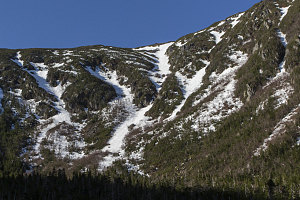
The Great Gully
There is one major obstacle in the Great Gully itself - a constriction and steep step about halfway up the Gully. During the winter months, a large bulge of ice typically builds up in this spot. Climbing the Great Gully through this constriction increases the technical difficulty of the route quite a bit, adding either a bit of rock climbing or ice climbing, depending on conditions.
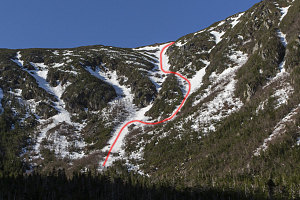
Great Gully Route
The alternative to climbing through the constriction is a bypass route: partway up the lower slopes of the Gully, one takes a right-hand detour into a shallower, parallel chute. This chute is climbed for a few hundred feet, until one is past the Great Gully's constriction, at which point a small access route allows passage back into the Gully. From this point it is a straightforward (but still somewhat steep) snow climb to the lip of the ravine. It was this easier variation that we were planning to climb today.
From our vantage point on the King Ravine Trail, all of the necessary sections to be climbed looked adequately filled with snow. The only question remaining: what shape the snow would be in? I knew from the avalanche reports that the snowpack was now fully isothermic and therefore stable, so the risk of an avalanche was very low. However, it was turning out to be a warm day... would the snow be too soft to climb?
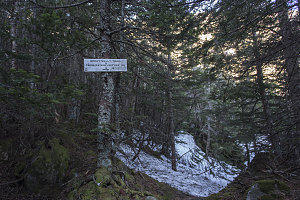
Start of Great Gully Trail
There was only one way to find out - go up and have a look. Continuing south on the King Ravine trail, we left the huge boulder fields behind and entered an area of short conifer forest. Minutes later we arrived at the junction with the Great Gully Trail. It appeared as if no one had been up recently - there was no sign of any footprints in the soft snow.

courtesy JInnes
Softening snow
Between a few widely-spaced tree blazes and the occasional bit of visible ground, we were able to follow (although with some difficulty) the first bit of the Great Gully Trail. Soon, though, the snowpack became continuous and quite deep, and the trees faded away to small, avalanche-scoured bushes, and there was no longer any hint of the trail. We simply angled upwards along the most reasonable-looking route.
We had arrived at the base of King Ravine's headwall, and the grade became quite steep. The strong sun and clear conditions made for a sweaty climb and fairly soft snow. We elected, in fact, to try our snowshoes on - perhaps they would be useful in these sorts of conditions.
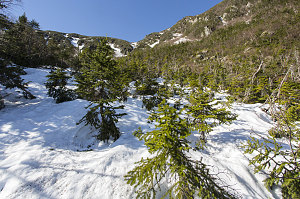
Thick snowpack
The widely-spaced scraggly conifers soon gave way to a wide and open laneway of brilliant white snow, stretching away upwards - the base of the Great Gully. As is pretty much always the case, it felt less steep up close than it had seemed when viewed face-on from farther away. Still steep, though - I estimate this section was perhaps 30 degrees.
Not too far up above, I could see the Gully's constriction. It was actually fairly devoid of ice, and from this angle looked not too bad. However, it wasn't in the cards for today. Today was about practicing basic snow-climbing skills - not mixed climbing.

courtesy JInnes
We didn't have a firm plan as to when we'd start our roped climbing. The 30-degree lower slopes of the Gully didn't seem steep or serious enough to warrant the ropes just yet, especially with a lack of a serious objective hazard below. So, we kept climbing individually - unroped - for the time being. As I climbed higher, the super-soft snow from below became a little more firm. It wasn't ideal for the snowshoes I had on, and I decided that I'd ditch them when we switched to roped climbing.
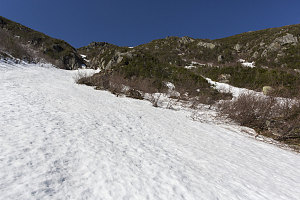
View towards the bypass
After about 100 feet of hot and sweaty climbing up the lower snow slopes, the side route over to "the bypass" came into view. I angled over to it, and after I made my way across, I stopped and let the others join me. Directly ahead of me I could see the laneway of the bypass leading upwards. It was steeper than the slopes we had just come up - enough, I thought to warrant breaking out the ropes. After a quick pow-wow with Brian and Jenn, we were all in agreement. We took the snowshoes off and got out the ropes, harnesses, ice axes, and snow protection

courtesy JInnes
View from the middle
As it turns out, Brian had forgotten one key piece of mountaineering gear - his ice ax. All he had for arrest protection were his ski poles - insufficient by themselves. My initial thought was that - in the interests of safety - we shouldn't do our climb, since a basic rule of steep snow climbing is that you have an ice ax and know how to use it. However, upon further reflection, I felt that we were still within a reasonable safety envelope. Not only would we be roped up, with myself and Jenn both using ice axes, but we were going to be putting in protection at all points along the climb. Coupled with the fact that the relatively soft snow conditions were not condusive to any sort of rapidly-accelerating falls, it wasn't a big deal that Brian didn't have an ax today. He'd have to be positioned at the rear, though, so that any fall could be best arrested by myself and Jenn from above. Brian likes the rearmost position anyway, so this suited him just fine.
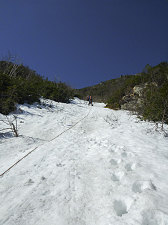
courtesy JInnes
Climbing the bypass
After getting roped up and in position, I started off up "the bypass". The footing was good even without snowshoes; in fact, at this slightly higher elevation and with a steeper aspect to the snow (hence a less direct angle to the sun), the snow was firmer, and my boots were no longer sinking in as much. I slowly kicked steps up the steep snow, putting in the first of our snow pickets after fifty feet or so.
Switchbacking on the way up to lessen the grade, we made our way up the bypass. The point at which we were to angle back into the Great Gully itself was quite obvious - a short open snow-filled laneway, less steep than both the bypass and the Great Gully. The laneway passed between some low scrub and a steep buttress of rock above.
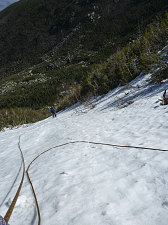
courtesy JInnes
At this point I had placed four of our five snow pickets, and was looking for a spot to set up a fixed belay so that we could reconvene to transfer the pickets from Brian (at the end of the rope, cleaning up the pickets) back to me. The laneway between the two gulleys was more sheltered and flatter, and so was an attractive spot to do this. I set up a quick belay station around a small but sturdy birch tree that was growing at the base of the steep rock buttress, and belayed up Jenn. Jenn then belayed up Brian, and we exchanged gear and took a short rest break. It was turning out to be a fairly easy snow climb, perhaps not requiring quite the level of rigour we were applying, but it was good practice, going through the motions of simulclimbing, setting protection, belays and all of the other logistics of this sort of climbing. Better to practice and become familiar with this stuff in an easy situation than becoming familiar with it on some sketchy and dangerous climb in bad weather!
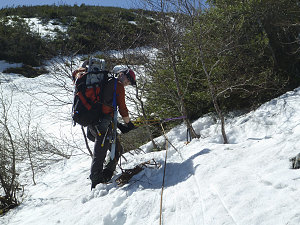
courtesy JInnes
With the transfer of gear back to me complete, I started off on our next pitch: the beginning of the climb of the upper part of the Great Gully.
Angling out into the center of the Gully, the snow below my position steepened out of view. Below us, I knew, was that steep constriction in the Gully - a real hazard into which one would not want to have an uncontrolled slide. Our roped climbing and snow pickets were a reassuring presence here.

courtesy JInnes
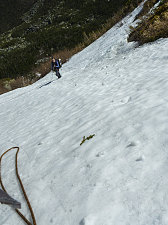
courtesy JInnes
Andrew climbing upper Great Gully
Although kicking steps in the snow was somewhat laborious, climbing up this part of the gully was fun - we had an established rhythm now, and the views were getting better with every step. We were far above the floor of the ravine, and we could see far out across the lower hills to the north.
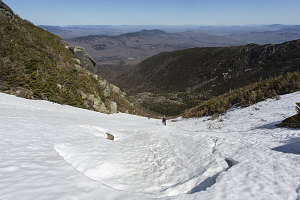
View from the Great Gully
Even though the day was hot and the sun was now shining on the full width of the laneway of snow we were climbing, it was still surprising how much the snow hardness differed depending on where we were positioned. On the more sunward side of the Ravine the snow was quite soft, sometimes bordering on slushy. On the less sunward side, the snow was actually bordering on being too hard to kick steps in. Like Goldilocks and the Three Bears, though, it was just right in the middle.
I had brought along a few pieces of protection other than pickets, on the off chance that I'd find an occasion to use them to extend the reach of our pitches. Since we were on a fairly narrow laneway of snow bordered by rocky walls, I switchbacked over from wall to wall and placed a couple of pieces of non-snow protection to spice things up.
Floor of Ravine far below